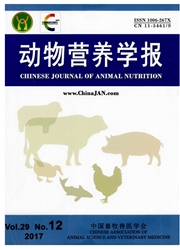

 中文摘要:
中文摘要:
为研究不同淀粉来源对生长猪门静脉养分及能量净吸收量的影响,试验选择杜×长×大三元杂种公猪4头,在门静脉、肠系膜静脉和颈动脉安装插管,进行4×4拉丁方试验。结果表明,试验猪每采食100g日粮8h后门静脉净吸收的葡萄糖和氨基酸总量以玉米组最高,分别为27.52和8.89g,显著高于抗性淀粉组(P〈0.05)。抗性淀粉、玉米、糙米和糯米组的门静脉总吸收能量分别为676.61、883.32、806.16和812.43J,其中以玉米组最高,抗性淀粉组显著低于其他各组(P〈O.05)。在门静脉总吸收的能量中,抗性淀粉组以葡萄糖形式吸收的能量显著低于其他各组(P〈0.05);而以VFA形式吸收的能量显著高于其他各组(P〈0.05);4种日粮均为以乳酸形式吸收的能量较低,占吸收总能量的3.22%~5.41%。玉米组门静脉总吸收的能量占摄入总能和消化能的比值分别为51.59%和55.55%,显著高于抗性淀粉组(P〈0.05)。由试验结果得出,不同淀粉来源在猪消化道中吸收的形式存在差异,而且提供能量的效率也不相同,主要以葡萄糖形式供能的淀粉源,能量利用效率较高;而主要以VFA或乳酸形式供能的淀粉源,能量利用效率较低。
 英文摘要:
英文摘要:
To study the effects of different dietary starch sources on net absorption of nutrients and energy through portal vein, four crossbreed D × L × y boars fitted with permanent catheters in the portal vein, mesenteric vein and carotid artery were arranged in a 4 × 4 Latin square experiment. The results showed that, net absorption of glucose and total amino acids per 100 g feed intake of growing pig in 8 hour post-prandial through portal vein in maize group respectively were 27.52 g and 8.89 g, which were significantly higher than those in resistant starch group (P〈0.05). The total net absorbed energy through portal vein in resistant starch, maize, brown rice and stick rice group were 676.61, 883.32, 806.16 and 812.44 J, respectively; and compared with that in other group, there was the highest total net absorbed energy through portal vein in maize group; while the total net absorbed energy through portal vein was the lowest in resistant starch diet group, which was significantly lower that than other groups (P〈0.05). In the total net absorbed energy through portal vein, absorbed energy in the form of glucose in resistant starch diet group was significantly lower than that in other groups (P〈0.05) ; while absorbed energy in the form of VFA in resistant starch diet group was significantly higher than that in other groups (P〈0.05) ; absorbed energy in the form of lactate was the lowest in all groups and it took up 3.22% -5.41% in the total net absorbed energy through portal vein. The percentage of total net absorbed energy through portal vein in general energy and di- gestible energy in maize group were 51.59% and 55.55%, which were significantly higher than those in resistant starch group (P〈0.05). It implicated that there exist difference in absorption form and energy availability in the digestive tract of pigs among different dietary starch sources; starch sources in the form of glucose supplying more energy had higher energy availabilities, while starch sources in the form of VFA or
 同期刊论文项目
同期刊论文项目
 同项目期刊论文
同项目期刊论文
 期刊信息
期刊信息
